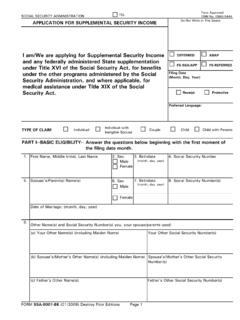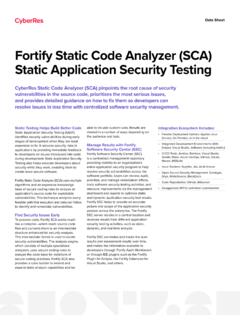Transcription of Creating Basic Reports with the SAP Query Tool
1 3 CHAPTERIn this chapterCreating Basic Reports with theSAP Query ToolThe SAP Query Tool24 Creating a Basic List Query by Using the SAP Query Tool24 Reviewing the Options on Each of the Five Basic Screens30 Modifying an SAP Query37 Saving a Query38 Maintaining 6/21/06 1:51 PM Page 2324 Chapter 3 Creating Basic Reports with the SAP Query ToolThis chapter describes how to create Basic list SAP Reports by using the SAP Query tool. Itintroduces everything you need to know to create Basic list type Reports in any applicationmodule of SAP.
2 The step-by-step setup of this chapter makes it easy for any user, regardlessof technical skill level, to create custom Reports by using the SAP Query HintAlthough it is recommended that you create SAP Query Reports live in your production environment, while youare learning how to use SAP, it is important that you practice in your test quality assurance client so you do notcause any problems in your production SAP Query ToolThe SAP Query tool, in its standard form, is designed so that an end user with no technicalskills can create a report from scratch.
3 It has five Basic screens that an end user can gothrough to create a report . Each of the screens performs a function, and the end user cannavigate between the screens by using navigational arrows on the Application toolbar. Theseare the five Basic screens: Title, Format (Screen 1) You use this screen to give a report a name. Select Field Group (Screen 2) You use this screen to select the field groups that con-tain fields you want to include in your report . Select Field (Screen 3) You use this screen to select the fields from the field groupsyou want to include in your report .
4 Selections (Screen 4) You use this screen to add any additional fields to your report sselection screen to further specify your report output upon execution. Basic List Line Structure (Screen 5) You use this screen to define what you wantthe report to look a Basic List Query by Using the SAPQ uery ToolThe most frequent comment I hear from fellow SAP customers is that they want the abilityto extract their own information. It is empowering to know that you can go into SAP andselect the data you want and have it come out formatted and sorted in the manner youchoose.
5 This section walks you through how to create a Basic list report by using the SAPQ uery tool. The following sections explain all the options on the screens used to create thequery create a Basic list Query by using the SAP Query tool, follow these in to your SAP client where your Query Reports will be created. (Best practice dic-tates that they be maintained in your live Production client.) 6/21/06 1:51 PM Page 2425 Creating a Basic List Query by Using the SAP Query to the Maintain Queries Initial screen by using the transaction code with R/3 release , SAP offers a graphical version of the SAP Query tool,called the Graphical Query Painter; if you have not used the SAP Query tool, theGraphical Query Painter is set as your default.
6 To turn off the Graphical Query Painterand learn to create easy step-by-step Reports by using the SAP Query tool, selectSettings, Settings and then deselect the Graphical Query Painter check title bar lists the Query group you are currently in. For example, your title barmight read Query from User Group ZTEST: Initial Screen. If you are assigned to mul-tiple Query groups, press F7 to see a list of all of discussed in Chapter 1, Getting Started with the SAP R/3 Query Reporting Tools, it is recommended that you create your queries in the standard Query area.
7 Ensure thatyou are in the standard Query area by selecting Environment, Query Areas and thenselecting Standard the Query field, type DLS_QUERY_01where DLSis your initials) as the name forthe Query you are Creating , and then click the Create button (see Figure ).3 Figure main screen ofthe SAP Query toollists all the queriesavailable in the desig-nated Query InfoSets of User Group ZTEST window appears, listing all the available InfoSets(that is, data sources) for your Query group. Because you created only one (in my exam-ple, I called it ZTEST), in Chapter 2, One-Time Configuration for Query Tool Use, it will be the only one listed.
8 Select the InfoSet you created (ZTEST, in my example)and then click the green check mark Create Query Title Format screen appears. This screen allows you to save thebasic formatting specifications for your Query , including the name (title) and any 6/21/06 1:51 PM Page 2526 Chapter 3 Creating Basic Reports with the SAP Query Toolyou want to store for the Query . The only required field is the Title (long reportdescription). For this example, fill in only the Title field, as shown in Figure , andthen click Save.
9 (For my example, I used the title (DLS) SAP Query Exercise #01.) 3 Navigational arrowsFigure Application tool-bar for the SAP Querytool contains naviga-tional arrows thatpermit you to navi-gate between thescreens of the to the next screen in the SAP Query creation process by selecting the NextScreen (white navigational arrow) button from the Application toolbar. (You can use thenavigational arrows to navigate between the different screens of the SAP Query tool.)The Select Field Group screen appears, listing all the Field groups available withinyour InfoSet.
10 Figure shows this screen with the field groups Flight Schedule[SPFLI], Flight Demo Table [SFLIGHT], and Flight Booking [SBOOK] a check mark next to each field group from which you want to include fields inyour report . Navigate to the next screen in the SAP Query creation process by selectingthe Next Screen (white navigational arrow) button on the Application toolbar. TheSelect Field screen appears, showing a list of all the available fields in the selected a check mark next to each field that you want to include in your report .

















